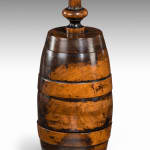George III Lignum Vitae Coffee Grinder
10 ¼ x 4 x 4 in
Further images
Of barrel or bullet shape. Topped with a screw-off stylised acorn finial. The body in three sections and with a folding iron handle.
Pinto comments that: ‘[o]n coffee’s introduction into England, the beans are said to have been brayed by a pestle and mortar. Naturally this laborious method of pulverizing, quickly created demand for a more mechanical contrivance.’ He illustrates a number of examples in ‘Treen and Other Wooden Bygones’ and explains that the design of coffee mills followed the same basic layout. (Edward H. Pinto, ‘Treen and Other Wooden Bygones’ (Bell & Hyman Limited, London, 1979), fig. 180.
Jonathan Levi illustrates a late 18th Century lignum vitae ‘bullet shaped’ coffee grinder, also with an acorn finial, in ‘Treen for the Table: Wooden Objects related to Eating and Drinking’ (Antique Collectors’ Club, Suffolk, 1988), p.118, plate 8/16.
In his book ‘Domestic Utensils of Wood’, Owen Evan-Thomas also illustrates a number of similar shaped coffee grinders (Stobart Davies, Hertford, 1992), plates 31 and 33






